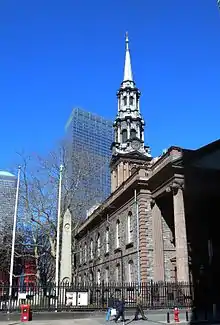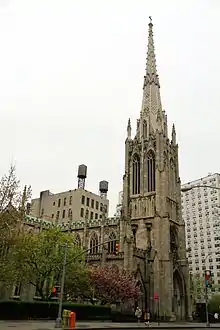Episcopal Diocese of New York
The Episcopal Diocese of New York is a diocese of the Episcopal Church in the United States of America, encompassing the boroughs of Manhattan, the Bronx, and Staten Island in New York City, and the New York state counties of Westchester, Rockland, Dutchess, Orange, Putnam, Sullivan, and Ulster.
Diocese of New York | |
|---|---|
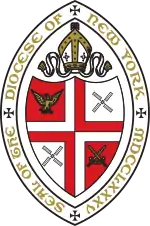 Seal of the Diocese of New York | |
| Location | |
| Country | United States |
| Territory | The Bronx, Dutchess County, Manhattan, Orange County, Putnam County, Rockland County, Staten Island, Sullivan County, Ulster County, Westchester County |
| Ecclesiastical province | Province II |
| Statistics | |
| Congregations | 193 |
| Members | 48,341 (2019) |
| Information | |
| Denomination | Episcopal Church |
| Established | June 22, 1785 |
| Cathedral | Cathedral of Saint John the Divine |
| Current leadership | |
| Bishop | Andrew M. L. Dietsche |
| Suffragans | Allen K. Shin Mary Glasspool (Assistant Bishop) |
| Map | |
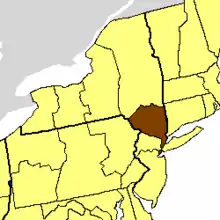 | |
| Website | |
| dioceseny.org | |
Established in 1785 after the success of the American Revolution resulted in the dis-establishment of the Anglican Church, it is one of the nine original dioceses of the Episcopal Church. It is one of ten dioceses, plus the Convocation of Episcopal Churches in Europe, that make up Province 2.
The diocesan offices are located in Manhattan near the Cathedral of St. John the Divine on Amsterdam Avenue. The Diocesan bishop is Andrew M. L. Dietsche, 16th Bishop of New York, assisted by Allen K. Shin, Suffragan Bishop, and Mary Glasspool, Suffragan Bishop.[1]
History
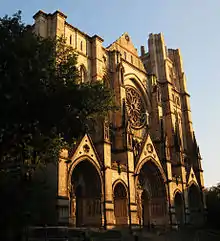
Early years
Anglicanism in New York can be traced to the acquisition of the territory from the Dutch in the latter part of the 17th century. In 1664, Charles II granted title to New Netherland to his brother, the Duke of York, the future James II.[2] British rule over New York was firmly established by 1674.[3] Initially, when it was a royal province under the direct control of the Roman Catholic James II, little was done to promote the Church of England in New York. In 1683, the New York Charter of Liberties and Privileges guaranteed religious tolerance and liberty.[4] After the Glorious Revolution, the British monarchy, especially William III and Anne, actively promoted the growth of the Church of England within the province. In 1693, the Church of England became the established church of New York (although certain accommodations were made for the Dutch Reformed Church).[2]
Between 1693 and 1694 Trinity Church in lower Manhattan and St. Peter’s Church, Westchester in what is today the Bronx, were established.[5] With royal patronage and the assistance of the Society for the Propagation of the Gospel in Foreign Parts (SPG), the church grew in the province through to the period of the American Revolution. During this time, the parishes in New York were under the direction of the Bishop of London. (Bonomi, 1998)
As the church grew in New York, and through the American colonies, the Church of England began to see the need to establish an episcopate in the Americas. This plan caused fear among a number of colonists and may have contributed to the American Revolution.(Bonomi, 1998) The Church's involvement in the creation of King's College (now Columbia University) and its large endowment far surpassing all other colonial colleges of the period, added to the fear of creating an episcopacy and of Crown influence in America through the college.
During the Revolution, many revolutionaries considered the church as harboring loyalties to the British Empire, as it was the established church in the empire, but not in the northern colonies. McConnell estimates that as many as 90 percent of New York’s Church of England clergy remained loyal to the Crown during the Revolution; they were concentrated in the lower part of the state, where merchants with trading relationships and other businessmen also were Loyalists. (McConnell 2003) After the Revolution, the church was disestablished in southern colonies. A number of prominent clergymen were imprisoned, including Samuel Seabury, the rector of St. Peter’s, Westchester, who later became the first Bishop of Connecticut.
In 1787, after an act was passed in Parliament whereby the English bishops were empowered to confer the episcopate upon men who were not subject to the British Crown, Samuel Provoost was consecrated as the first bishop of New York by John Moore, the Archbishop of Canterbury, William Markam, the Archbishop of York, and Charles Moss, Bishop of Bath and Wells.
In 1789, the Episcopal Church was formally separated from the Church of England so that clergy would not be required to take an oath to the Crown. (McConnell 2003)
Samuel Provoost
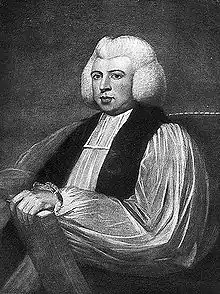
The selection of Provoost served to mollify the anti-Anglican sentiments, which rose during the Revolution. In his Addresses on the History of the United States Senate, Senator Robert Byrd noted that in the years before the Revolution, Provoost "was a passionate Whig, and his sympathy for the colonies against English rule did not sit well with his wealthy loyalist congregation. Before long, his patriotism cost him his parish. During the Revolution, Provoost . . . narrowly escaped capture and death at the hands of the British." [6] His Revolutionary credentials established, the first U.S. Senate, located with the government temporarily in New York, chose Provoost as its first Chaplain in 1789. After the inauguration of George Washington as the first President of the United States, the new President together with the members of Congress proceeded to St. Paul's Chapel, where Provoost led a prayer for the new government.
During his tenure, the Diocese devoted considerable effort and money to the expansion of the faith in other parts of New York, most notably in the area which now comprises the Episcopal Diocese of Albany.[7] From 1792 to 1795, Provoost served as the 3rd Presiding Bishop of the church.
Oxford Movement
In the 1830s and 1840s, the Oxford Movement caused controversies and divisions within the diocese, as it did elsewhere within the church and the broader Anglican community. In New York, these divisions crystallized over a dispute over the ordination of Arthur Carey. Carey, a graduate of the General Theological Seminary, was greatly influenced by the Tracts for the Times, and as his ordination approached, he was opposed by a number of clergy and laity.,[8][9] Benjamin Onderdonk and other presbyters conducted an examination of Carey, which ultimately found him fit for ordination, which was celebrated in 1843. The dispute did not end there, and a number of letters were published accusing Carey and ultimately Onderdonk of being overly sympathetic to Roman Catholicism.[10] This controversy spread beyond the diocese, and at least one other diocese adopted a resolution condemning Onderdonk.[11]
As this controversy continued, charges were presented to the House of Bishops alleging that Onderdonk had committed an "immoral act" with a Mrs. Butler and other women (charges of intoxication were also mentioned, but downplayed).[12] After a trial, the House of Bishops suspended Onderdonk.[13] Whether or not this was the result of the dispute over the issues raised by the Carey affair was hotly debated at the time, in a series of tracts and published letters of the parties involved.[12] William Manross notes in A History of the American Episcopal Church (1935) that the verdict against Onderdonk reflects "the bitter party feeling which prevailed at the time, especially as the voting throughout the trial was pretty much along party lines, all of the evangelicals voting to condemn Bishop Onderdonk and most, though not all, of the High Churchmen voting to acquit him."[13]
Recent developments
In 2003 the Diocese had 64,000 members. This decreased to 60,000 in 2013 and 59,035 in 2014.[14] The 2016 figure is 51,309 members.
Bishops of New York
These are the bishops who have served the Diocese of New York:,[15][16]
- Samuel Provoost (1787 - 1815); resigned 1801
* Benjamin Moore, Assistant (1801 - 1815); served in the place of Provoost
* John Henry Hobart, Assistant 1811; served in the place of Moore when disabled that year. - Benjamin Moore (1815-1816)
- John Henry Hobart, (1816 - 1830)
- Benjamin T. Onderdonk (1830 - 1861); suspended 1845 - 1861
- Jonathan M. Wainwright, Provisional (1852 - 1854); served in the place of Onderdonk
- Horatio Potter, Provisional (1854 - 1861); served in the place of Onderdonk; Diocesan (1861 - 1887)
* Henry C. Potter, Assisting (1883 - 1887) - Henry C. Potter (1887 - 1908)
* David H. Greer, Coadjutor (1904 - 1908) - David H. Greer (1908 - 1919)
* Charles S. Burch, Suffragan (1911 - 1919) - Charles S. Burch (1919 - 1920)
- William T. Manning (1921 - 1946)
* Arthur S. Lloyd Suffragan (1921 - 1936)
* Herbert Shipman, Suffragan (1921-1930)
* Charles K. Gilbert, Suffragan (1930 - 1946) - Charles K. Gilbert (1947 - 1950)
* Horace W. B. Donegan, Suffragan (1947 - 1950); Coadjutor (1950) - Horace W. B. Donegan (1950 - 1972)
* Charles F. Boynton, Suffragan (1951 - 1969)
* J. Stuart Wetmore, Suffragan (1960 - 1987)
* Paul Moore, Jr., Coadjutor, (1969 - 1972) - Paul Moore, Jr. (1972 - 1989)
* Harold L. Wright, Suffragan (1974 - 1978)
* Walter Decoster Dennis, Jr., Suffragan (1979 - 1998)
* Richard F. Grein, Coadjutor (1989) - Richard F. Grein (1989 - 2001)
* E. Don Taylor, Assistant/Vicar for New York City (1994–2009)
* Catherine S. Roskam, Suffragan (1996–2012)
* Herbert A. Donovan Jr., Assisting - Mark S. Sisk (2001–2013)
- Andrew M. L. Dietsche (2013–present)
* Allen K. Shin, suffragan
Churches
Manhattan
- All Angels' Church
- Christ & Saint Stephen's Episcopal Church
- Church of the Ascension
- Church of the Holy Apostles (Manhattan)
- Church of the Incarnation, Episcopal (Manhattan)
- Grace Church (Manhattan)
- Church of the Holy Trinity
- St. Augustine's Church, Manhattan
- St. Bartholomew's Episcopal Church, New York
- St. Clement's Episcopal Church
- St. George's Episcopal Church
- St. James' Episcopal Church
- Church of St. Luke in the Fields
- St. Mark's Church in-the-Bowery
- Church of Saint Mary the Virgin (Times Square)
- St. Michael's Episcopal Church (Manhattan)
- St. Paul's Chapel
- St. Peter's Episcopal Church (Manhattan)
- St. Philip's Episcopal Church (Harlem, New York)
- St. Thomas' Church (Manhattan)
- Trinity Church (Manhattan)
- Church of the Epiphany (Manhattan)
- Church of the Resurrection (Manhattan)
- Church of the Transfiguration (Manhattan)
- St. Mary's Episcopal Church, Manhattanville
The Bronx
- Christ Church, Bronx
- Grace Episcopal Church, City Island - Located in City Island, Bronx.
- Grace Episcopal Church, Bronx - Located in West Farms, Bronx.[17]
- Episcopal Church of the Mediator
- St. Ann's Church, Bronx
- St. James' Episcopal Church and Parish House
- St. Stephen Episcopal Church
- Church of the Atonement
- Church of the Good Shepherd
- Haitian Congregation of the Good Samaritan
- Holy Nativity Episcopal Church
- St. Andrew's Episcopal Church
- St. David's Episcopal Church
- St. Edmund's Episcopal Church
- St. Joseph's Episcopal Church
- San Juan Bautista Church
- St. Luke's Episcopal Church
- St. Martha's Episcopal Church
- St. Paul's Episcopal Church
- St. Peter's Episcopal Church
- St. Simeon's Episcopal Church
- St. Stephen's Episcopal Church
- Trinity Episcopal Church of Morrisania
Westchester
- St. Augustine's Episcopal Church Complex
- St. Matthew's Church, Bedford, NY
- St. Stephen's Church, Armonk, NY
- St. John's Church - St. Paul's Chapel, South Salem, NY
- St. Thomas' Church, Mamaroneck, NY
- St. Simon the Cyrenian Church, New Rochelle, NY
- St. Andrew's Church, Hartsdale, NY
- The Church of SS John, Paul & Clement, Mount Vernon, NY
- The Church of St. Barnabas, Irvington, NY
- St. Peter's Church, Port Chester, NY
- Holy Cross Church, Yonkers, NY
- The Church of St. James the Less, Scarsdale, NY
- Grace Church - La Gracia, White Plains, NY
- St. Peter's Church, Peekskill, NY
- St. Paul's on-the-Hill Church, Ossining, NY
- The Church of St. Mary the Virgin, Chappaqua, NY
- St. Augustine's Church, Croton-on-Hudson, NY
- St. Paul's Church, Yonkers, NY
- St. Barnabas' Church, Ardsley, NY
- The Church of the Ascension, Mount Vernon, NY
- Grace Church, Hastings-on-Hudson, NY
- St. Bartholomew's Church, White Plains, NY
- Church of the Divine Love, Montrose, NY
- St. Francis & St. Martha's Church, White Plains, NY
- Christ's Church, Rye, NY
- Iglesia San Andres, Yonkers, NY
- The Church of the Good Shepherd, Granite Springs, NY
- St. Mary's Church (Scarborough), Briarcliff Manor, NY
- St. Mary's Church, Mohegan Lake, NY
- St. James' Church, North Salem, NY
- St. Mark's Church (Nepera Park), Yonkers, NY
- Christ Episcopal Church (Tarrytown, New York) and San Marcos Mission
- St. Mark's Church, Mount Kisco, NY
- St. Luke's Church, Somers, NY
- St. Luke's Church, Katonah, NY
- St. Luke's Church, Eastchester, NY
- Christ Church, Bronxville, NY
- St. John's Church, Pleasantville, NY
- St. John's Church (Fountain Square), Larchmont, NY
- The Parish of Christ the Redeemer, Pelham, NY
- Trinity Church, Ossining, NY
- Trinity Church, Mount Vernon, NY
- All Saints' Church, Harrison, NY
- St. Joseph of Arimathea Church (Elmsford), White Plains, NY
- St. John's Church (Getty Square), Yonkers, NY
- All Saints' Church, Briarcliff Manor, NY
- Trinity St. Paul's Church, New Rochelle, NY
- St. John's Church (Tuckahoe)., Yonkers, NY
- Zion Church, Dobbs Ferry, NY
- St. John's Church (Wilmot), New Rochelle, NY
[18]===Orange County===
- Christ Episcopal Church, Warwick, NY
- Church of the Good Shepherd, Newburgh, NY
- Church of the Good Shepherd, Greenwood Lake, NY
- Church of the Holy Innocents, Highland Falls, NY
- St. Francis of Assisi Church, Montgomery, NY
- Grace Episcopal Church, Middletown, NY
- Grace Episcopal Church, Monroe, NY
- Grace Episcopal Church, Port Jervis, NY
- St. Andrew's Church, Walden, NY
- St. Anne's Church, Washingtonville, NY
- St. George's Church, Newburgh, NY
- St. James' Church, Goshen, NY
- St. John's Church, Cornwall, NY
- St. Mark's Church, Fort Montgomery, NY
- St. Mary's-In-Tuxedo, Tuxedo Park, NY
- St. Paul's Church, Chester, NY
- St. Thomas' Church, New Windsor, NY
Ulster County
- St. John's Church, Kingston, NY
- Holy Cross/Santa Cruz Episcopal Church, Kingston, NY
- Christ the King Church, Stone Ridge, NY
- Trinity Church, Saugerties, NY
- St. Andrew's Church, New Paltz, NY
- St. Gregory's Church, Woodstock, NY
- St. John's Memorial Church, Ellenville, NY
- Ascension Church, West Park, NY
- Christ Church, Marlboro, NY
- Holy Trinity Church, Highland, NY
Dutchess County
- Christ Episcopal Church, Poughkeepsie, NY
- Christ Episcopal Church, Red Hook, NY
- Church of St. John the Evangelist, Red Hook, NY
- St. Andrew & St. Luke Church, Beacon, NY
- St. James' Church, Hyde Park, NY
- St. Mark's Church, Wappingers Falls, NY
- St. Nicholas-on-the-Hudson, New Hamburg, NY
- St. Paul's Church, Poughkeepsie, NY
- Trinity Church, Fishkill, NY
Source:[19]
Educational and other institutions
Spiritual communities
There are a number of Spiritual Communities and Religious Orders active within the Diocese. Among these are:
- The Order of the Holy Cross – Holy Cross Monastery
- The Community of the Holy Spirit
- The Order of St Helena
- The House of the Redeemer
- The Society of St. Francis
- The Society of St. Margaret
- The Brotherhood of St. Gregory
- Incarnation Center
Schools
The 2003 edition of the Episcopal Church Annual lists seven Episcopal schools in New York:
- Children's Garden at The General Theological Seminary, 175 Ninth Avenue, New York
- St. Hilda's & St. Hugh's School, 619 W. 114th Street, New York
- The Cathedral School of St. John the Divine, 1047 Amsterdam Avenue, New York
- The Episcopal School in the City of New York, 35 East 69th Street, New York
- The Melrose School, 120 Federal Hill Road, Brewster, New York
- Trinity-Pawling School, 700 Route 22, Pawling, New York
See also
- Seamen's Church Institute of New York and New Jersey (Episcopal Seafarers' Advocacy founded in 1834)
References
Citations
- https://www.dioceseny.org/the-diocese/our-bishops/
- New York to Pennsylvania 1664-1744 by Sanderson Beck
- History of the U.S.A.: New York
- Charter of Liberty and Privileges, 1683
- Trinity Church history
- Senate history: Senate chaplain
- "Diocese of Albany history". Archived from the original on 2006-04-22. Retrieved 2006-06-14.
- "Episcopal Church Office of Liturgy and Music: Arthur Carey". Archived from the original on 2006-06-16. Retrieved 2006-06-17.
- The Ordination of Mr. Arthur Carey, Project Canterbury.
- "A letter to a Parishioner relative to the Recent Ordination of Mr. Arthur Carey"
- The Novelties which Disturb Our Peace, Project Canterbury:
- Project Canterbury: Statement of Bishop Meade
- Episcopal Church Office of Liturgy and Music: Benjamin Tredwell Onderdonk Archived June 23, 2006, at the Wayback Machine
- Episcopal Church membership statistics
- The Episcopal Church Annual. Morehouse Publishing: New York, NY (2005)
- "Diocese of New York list of bishops". Archived from the original on 2007-12-15. Retrieved 2006-06-14.
- "Grace Episcopal Church, West Farms, Bronx, NY". Episcopal Church. 13 June 2011. Retrieved 15 April 2018.
- Episcopal Directory
- "New York Episcopal Church". Episcopal Church. 28 July 2011. Retrieved 7 October 2017.
Sources
- Bonomi, Patricia U. (1988) Under the Cope of Heaven: Religion, Society, and Politics in Colonial America
- McConnell, Michael W. (2003) "Establishment and Disestablishment at the Founding, Part I: Establishment of Religion" William and Mary Law Review
- "Senate Chaplain" in by Senator Robert C. Byrd, from The Senate, 1789-1989: Addresses on the History of the United States Senate Washington: Government Printing Office, 1989
External links
- Episcopal Diocese of New York Web site
- Journal of the Annual Convention, Diocese of New York partial series archive at the Online Books Page
